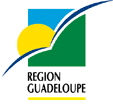|
Guadeloupe
More Caribbean Islands Travel Guide - Hotels - Rental Cars and
Resort vacations
Find a premier Hotel & Resort at
Hilton Hotels.
or book Sheraton Hotels and Resorts
|
|
|
 |
Guadeloupe is an archipelago in the eastern
Caribbean Sea, with a total area of 1,702 km².
It is an overseas département (département
d'outre-mer, or DOM) of France. Like the other
DOMs, Guadeloupe is also one of the 26 régions
of France (as a région d'outre-mer), and an
integral part of the Republic.
Guadeloupe comprises five islands: Basse-Terre,
Grande-Terre (separated from Basse-Terre by a
narrow sea channel called salt river) with the
adjacent islands of La Désirade, Les Saintes and
Marie-Galante. Basse-Terre has a rough volcanic
relief whilst Grande-Terre features rolling
hills and flat plains.
Further to the north, Saint-Barthélemy and the
French part of Saint Martin come under the
jurisdiction of Guadeloupe. On December 7, 2003,
both of these areas voted to become an overseas
territorial collectivity |
|
|
History
View from GuadeloupeGuadeloupe was populated
from 300 BC by the Arawak Amerindians, who
fished and developed agriculture on the island.
It was next inhabited by the Caribs, who pushed
out most of the Arawak in the 8th century, and
who renamed the island "Karukera" or the "Island
of beautiful waters".
During his second trip to America Christopher
Columbus became the first European to land on
Guadeloupe on 14 November 1493. He called it
Santa María de Guadalupe de Extremadura, after
the image of the Virgin Mary venerated at the
Spanish monastery of Villuercas, in Guadalupe,
Extremadura.
The French took possession of the island in 1635
and wiped out many of the Carib. It was annexed
to France in 1674. Over the next century, the
island was seized several times by the British.
One indication of Guadeloupe's prosperity at
this time is that in the Treaty of Paris (1763),
France abandoned its territorial claims in
Canada in return for British recognition of
French control of Guadeloupe.
Carbet FallsIn an effort to take advantage of
the chaos ensuing from the French Revolution,
Britain attempted to seize Guadeloupe in 1794
and held it from April 21 to June 2. The French
retook the island under the command of Victor
Hugues, who succeeded in freeing the slaves.
They revolted and turned on the slave-owners who
controlled the sugar plantations, but when
American interests were threatened, Napoleon
sent a force to suppress the rebels and
reinstitute slavery. Louis Delgrès and a group
of revolutionary soldiers killed themselves on
the slopes of the Matouba volcano when it became
obvious that the invading troops would take
control of the island. The occupation force
killed approximately 10,000 Guadeloupeans in the
process of restoring "order" to the island.
On February 4, 1810 the British once again
seized the island and held it until March 3,
1813, when it was ceded to Sweden as a
consequence of the Napoleonic Wars. Sweden
already had a colony in the area, but merely a
year later Sweden left the island to France in
the Treaty of Paris of 1814. An ensuing
settlement between Sweden and the British gave
rise to the Guadeloupe Fund. French control of
Guadeloupe was finally acknowledged in the
Treaty of Vienna in 1815. Slavery was abolished
on the island in 1848 at the initiative of
Victor Schoelcher. Today the population of
Guadeloupe is a blend of Europeans, Africans and
Indians.
Main Article: Geography of Guadeloupe
Guadeloupe comprises five islands: Basse-Terre,
Grande-Terre (separated from Basse-Terre by a
narrow sea channel called salt river) with the
adjacent islands of La Désirade, Les Saintes and
Marie-Galante. Basse-Terre has a rough volcanic
relief whilst Grande-Terre features rolling
hills and flat plains.
Further to the north, Saint-Barthélemy and the
French part of Saint Martin come under the
jurisdiction of Guadeloupe. On December 7, 2003,
both of these areas voted to become an overseas
territorial collectivity
|
|
|
Background:
|
Guadeloupe has been a French possession since 1635.
The island of Saint Martin is shared with the
Netherlands; its southern portion is named Sint
Maarten and is part of the Netherlands Antilles and
its northern portion is named Saint-Martin and is
part of Guadeloupe |
|
Location:
|
Caribbean, islands in the eastern Caribbean Sea,
southeast of Puerto Rico |
|
Geographic coordinates:
|
16 15 N, 61 35 W
|
|
Map references:
|
Central America and the Caribbean |
|
Area:
|
total: 1,780 sq km
note: Guadeloupe is an archipelago of nine
inhabited islands, including Basse-Terre,
Grande-Terre, Marie-Galante, La Desirade, Iles des
Saintes (2), Saint-Barthelemy, Iles de la Petite
Terre, and Saint-Martin (French part of the island
of Saint Martin)
water: 74 sq km
land: 1,706 sq km |
|
Area - comparative:
|
10 times the size of Washington, DC |
|
Land boundaries:
|
total: 10.2 km
border countries: Netherlands Antilles (Sint
Maarten) 10.2 km |
|
Climate:
|
subtropical tempered by trade winds; moderately high
humidity |
|
Terrain:
|
Basse-Terre is volcanic in origin with interior
mountains; Grande-Terre is low limestone formation;
most of the seven other islands are volcanic in
origin |
|
Geography - note:
|
a narrow channel, the Riviere Salee, divides
Guadeloupe proper into two islands: the larger,
western Basse-Terre and the smaller, eastern
Grande-Terre |
|
Nationality:
|
noun: Guadeloupian(s)
adjective: Guadeloupe |
|
Ethnic groups:
|
black or mulatto 90%, white 5%, East Indian,
Lebanese, Chinese less than 5% |
|
Religions:
|
Roman Catholic 95%, Hindu and pagan African 4%,
Protestant 1% |
|
Languages:
|
French (official) 99%, Creole patois |
|
Currency:
|
euro (EUR); French franc (FRF) |
|
Currency code:
|
EUR; FRF |
|
Exchange rates:
|
Euros per US dollar - 1.1324 (January 2002), 1.1175
(2001), 1.0854 (2000), 0.9386 (1999); French francs
per US dollar - 5.8995 (1998), 5.8367 (1997) |
|
|
|
|
|

